What’s the #1 reason people visit the family doc? The common cold. The #2 reason? Lower back pain.
80% of adults report lower back pain at some point in their lives and 10-15% of all sports-related injuries involve the spine. Low back pain accounts for more lost person hours than any other type of occupational injury and is the most frequent cause of activity limitation in those under age 45.
Thus, it’s important to understand what the spine is, what it does, and — most importantly — how we can keep it healthy.
What is the spine?
Along with opposable thumbs that we can use to work the TV remotes we invented, one of the things that distinguishes us from many other animals is our spine. The spine provides structural support for our bodies, protection for our central nerves, and facilitates locomotion (aka movement).
The spine is made up of 24 semi-rigid presacral vertebrae (seven cervical, twelve thoracic, five lumbar) separated by discs. Five sacral vertebrae fuse to make up the sacrum, which helps transfer upper body weight to the pelvis through the sacroiliac joint. The coccyx (tailbone) makes up the bottom of the vertebral column.
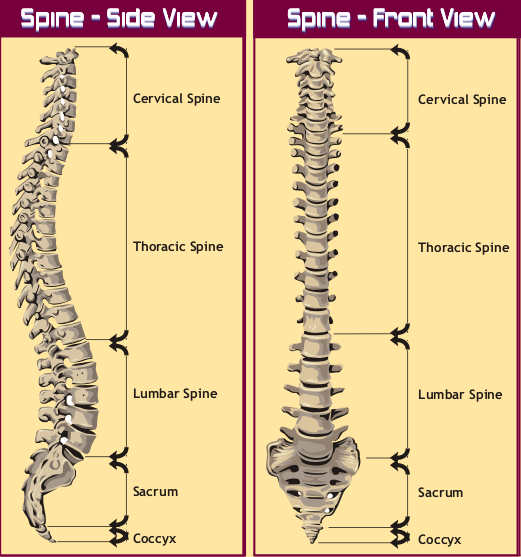
Intervertebral discs hold vertebrae together, act as shock absorbers, and allow dynamic spinal movement. These discs measure around one centimeter in height and consist of a gooey center (nucleus pulposus) surrounded by connective tissue (annulus fibrosis). (Think of an Oreo with the disc as the filling and the vertebrae as the hard cookies.)
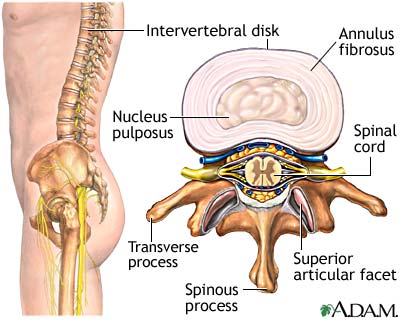
Bony projections come together along your mid-back to form the spinous process, which you can feel and see.
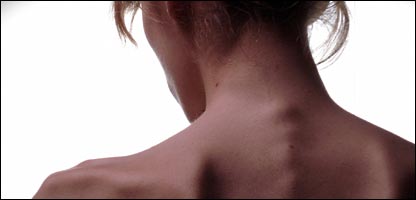
Ligaments run along the spine and provide stability, helping the spine protect nerves extending from brain to body.
Spinal muscles and their roles
Several muscle groups attach to the spine or play a critical role in spinal health. Problems with these muscles can cause back pain. (For more on how this works, see the next section.)
1. Iliopsoas (psoas + iliacus) complex
These lie deep within the abdomen and hip, connecting the lumbar vertebrae and the iliac crest to the top of the femur. They’re major movers during bent knee leg raises and sit ups.
Aggravated with: Lots of sitting/driving, lots of kicking (martial arts or soccer), long bike rides in bent position, and sleeping in the fetal position.
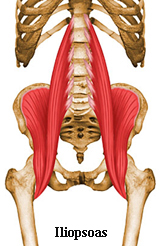
2. Paraspinals
These are like the spine’s “suspenders” and help to control rotation, extension and bending. This group includes the erector spinae and multifidus along the spine.
Aggravated with: Sudden spinal overload, repetitive movement with poor technique, hunched posture, tight abdominal muscles, and lots of sitting.
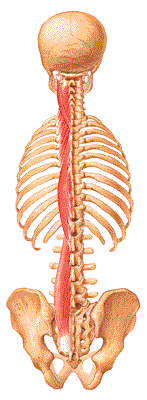
3. Rectus abdominis
This sheet of muscle is your “washboard abs”. It runs between the lowest ribs and top of the pubic bone, and helps stabilize the torso. Excessive training of the rectus abdominis (at the expense of posterior chain muscles) can diminish the ability to carry weight overhead (think jerks, snatches, overhead presses) and lead to lower back injury. So: fewer crunches, more swings.
Aggravated with: Too many crunches (especially without posterior chain training), over-exercising, excess abdominal fat, reliance on weight training belts.
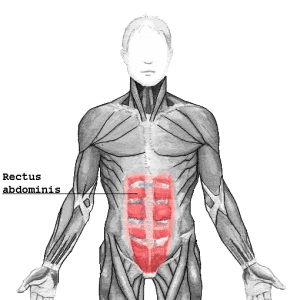
4. Gluteus group: maximus/medius/minimus
Aka the booty, these are the muscles that help bring your thigh behind you (think: donkey kicks), rotate it, and bring it to the side.
Aggravated with: Prolonged sitting, sleeping in fetal position with knees pulled up, sitting on your wallet, standing for long periods on one leg, sleeping on your back with feet splayed under the weight of a heavy blanket.
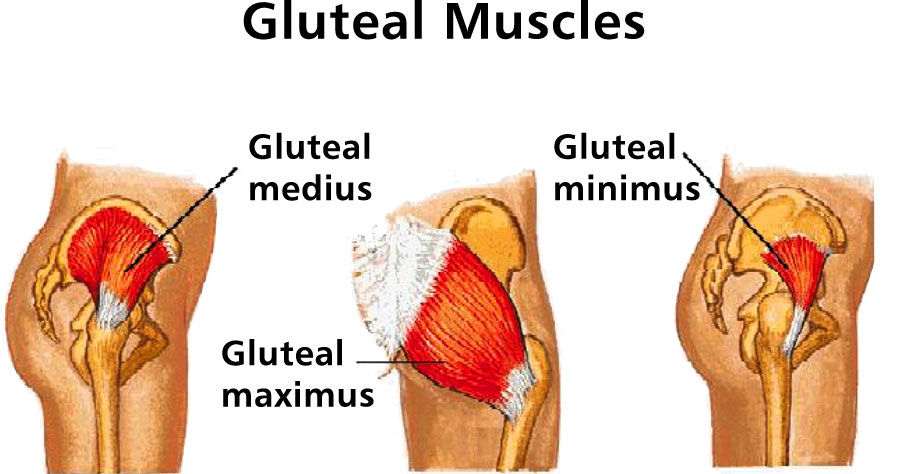
5. Piriformis
This small muscle lies deep within the glutes and connects the thigh to the pelvis near the sacrum. It rotates the thigh outward and swings the leg to the side when the thigh is flexed.
Aggravated with: Distance running (repetitive overuse in general), prolonged contraction (such as driving a car), sitting with one foot underneath you, walking with duck feet (toes out), sitting too much.
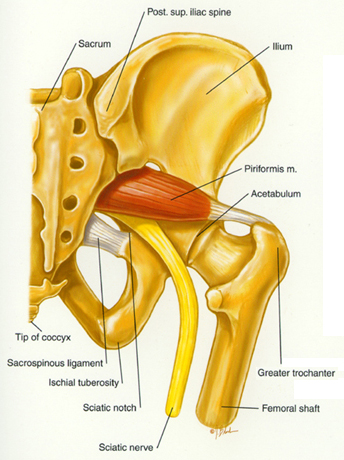
6. Quadratus lumborum
The “QL” lies deep in the side of the torso around the kidneys. It helps to bend, rotate, and straighten the torso from bent position. It also helps with exhalation (coughing, etc.), which many folks discover when they strain the QL and then live in fear of sneezing.
Aggravated with: Structural imbalances (one leg longer, uneven pelvis, etc.), habitual leaning to one side, slouching, always sleeping on one side.
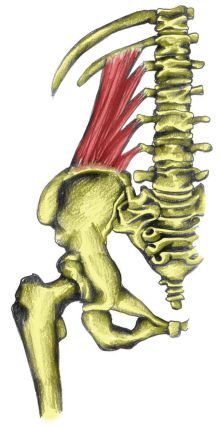
7. Hamstrings
These big leg muscles run along the back of the thighs, attaching at the hip and the knee. They bend and stabilize the knee.
Aggravated with: Pressure from chairs, prolonged sitting, bed rest, overload (e.g. lots of sprints when a trainee isn’t used to sprinting).

8. Soleus
This deep calf muscle assists with walking, jumping, and pointing the toes. When irritated, pain can radiate to the sacrum.
Aggravated with: High heeled shoes, rigid/tight shoes, bedding that weighs down toes, standing still for extended periods, prolonged driving, sitting on chair that is too high (so the feet don’t touch the floor).
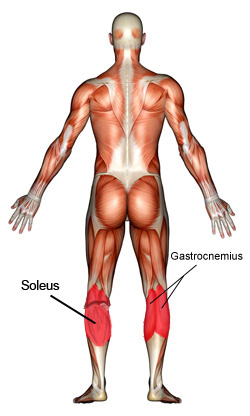
What can lead to spinal problems?
Usually, spinal problems are multifactorial. Predisposing factors include:
- Poor mobility in surrounding muscles
- Bad biomechanics
- Poor posture
- Weakness of supporting musculature
- Muscle imbalances
- Sedentary lifestyle, sitting, and immobility
Poor mobility in surrounding muscles
The pelvis is the foundation for the spine. Decreased mobility in the hips, hamstrings, ankles, and thoracic spine can lead to overcompensation at the lumbar spine and excessive pelvic tilt. This problem is particularly common in women — in part because of higher heels, but also because the connective tissues of an average woman’s spine are usually looser than the average man’s.
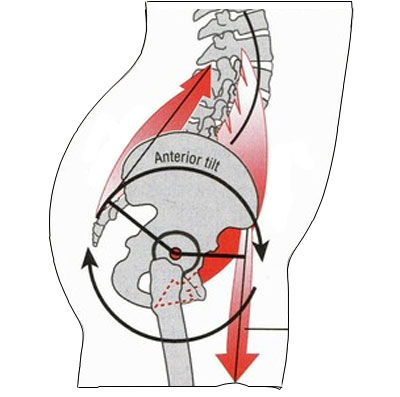
Bad biomechanics
Back pain only gets worse with poor biomechanics.
Most spine injuries that occur during training are muscle strains or ligament sprains, usually due to improper loading and technique. A common error is lumbar flexion during movements like good mornings, sit-ups, deadlifts, and rows. Excessive lumbar extension is also dangerous and can lead to vertebral fracture (e.g., finishing a heavy deadlift).
The safest position for the lumbar spine is a neutral position — a natural but not exaggerated S-curve (double check the spine image at the top of this article for reference). You can find a neutral spine by flexing your lumbar spine, then extending it and trying to find the midpoint between the two, or by standing tall and taking a deep breath. Use a mirror to check.

It’s important to get good at the movements you regularly do. If you’re always lunging and twisting for martial arts or your plumbing job, get good at lunging and twisting. Don’t just go home at night and do sit-ups hoping to preserve your back.
*Illustration courtesy of Bony to Beastly.
Poor posture
If your posture sucks, your back sucks.
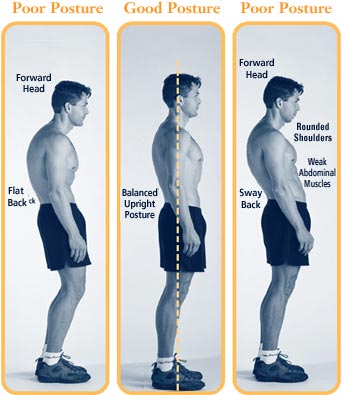
Poor posture means higher levels of shear stress on the spine. When posture is appropriate (proud chest, natural lumbar curve, tight core, retracted shoulder blades, etc.) – then we’re able to handle higher amounts of compressive force. Oh, a big gut and high heeled shoes can negatively influence posture. Try to avoid one or both as much as possible.
Weakness
Many people assume that strong abs help them bend and twist. This is true, in part, but most often the core’s role is stability rather than movement — in other words, preventing motion rather than initiating it. Too much flexion or extension at the lumbar spine, usually caused by weak core muscles, can lead to injury. It’s also biomechanically weaker. You can throw a lot farther or punch a lot harder when your hips and shoulders are involved than when you’re just twisting at the waist.
Reliance on weight lifting belts can lead to torso stiffness and weakness.
Imbalances
Folks with chronic back pain often neglect the posterior chain (i.e. the muscles that run along the rear of the body from neck to ankles). This is especially true for gym rats who do too much bench pressing and not enough pulling or hip extension. This keeps back problems in full force (plus said gym rats end up looking like light bulbs).
Single leg exercises help develop the lower body and immediately challenge the lower back and hips, building stability and function. We tend to be weak and imbalanced on extension movements because we do them less.
Not moving
Doctors used to recommend bed rest for back pain. Now they usually recommend movement. And, as you can see from the list of muscle problems above, “too much sitting” factors into a host of back problems.
When we sit or lie around all day, intervertebral discs absorb fluid and become tighter, allowing less range of motion and promoting injury. Introduce yourself to regular movement (warm ups, yoga, and dynamic joint mobility, along with walking and swimming). These all help to preserve spinal health. See here:
All About Dynamic Joint Mobility
Other common problems
“Spondylo”s
A collection of spinal dysfunctions known as the “spondys” can result from spinal fracture, overtraining, and/or over-extension/twisting of the spine. They’re common, for instance, in gymnasts and yogis who repeatedly bend backwards. They can also occur acutely in high-impact sports such as rugby.
- Spondylitis is an inflammation of the vertebrae.
- Spondylosis is osteoarthritic narrowing of the vertebral space.
- Spondylolysis is a fracture, usually a stress fracture, of the pars interarticularis. It can lead to a spondylolisthesis.
- Spondylolisthesis, which can occur after a spondylolysis, is the forward slippage of one vertebrae on another. Think of a stack of books in which one book is pushed forward.
Excessive flexion, extension and rotation are bad news for anyone with spondylo-situations. Work on building mobility of the hip flexors, hamstrings and ITB.
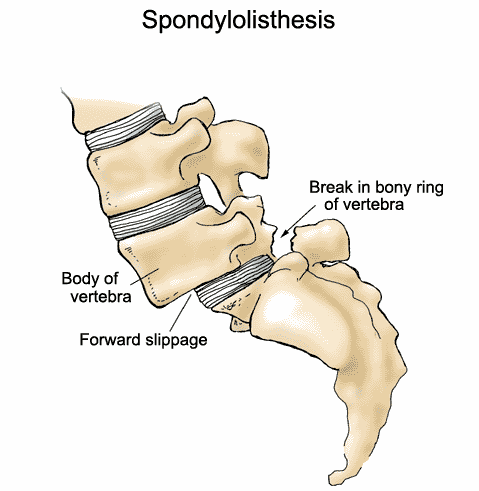
Prolapsed disc
This occurs when intervertebral disc material bulges from its normal confines. Minor tears to the outside of discs can lead to inner disc leakage.
The key is to never let the problem start. Translation: build core stability.
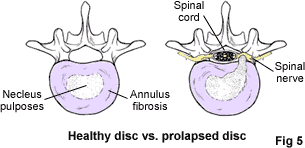
Treating and preventing spinal dysfunction
Get moving
As mentioned above, movement is good, and inactivity can cause/exacerbate back pain.
- Resistance training helps build strength and endurance in the supporting musculature, and help activate weaker or inhibited areas.
- Mobility training helps improve active flexibility in tight areas.
- The intervertebral discs lack blood vessels. The only way they can absorb nutrients is through spinal movement. If you want to deprive your discs of nourishment, lie down and sit around a lot.
But before you randomly start lifting, running, twisting and jumping, think WWDMD (What Would Dr. McGill Do)? Spine biomechanicist Dr. Stuart McGill encourages the following approach when it comes to exercise design:
- Do necessary corrective exercises
- Groove appropriate movement patterns
- Build full body joint mobility/stability
- Increase core endurance (rather than maximal strength)
- Build full body strength
- Develop speed, power, and agility
How many people do you know that start at #1?
Spines & squatting
Squatting with poor mechanics will result in injury.
Squatting with added weight puts compressive forces on the spine. Why don’t we see more spinal blowouts at the gym? Luckily, our spine can adapt to compressive tolerance. But our spines need time to adapt. Take your time and allow this adaptation. To assist the process, build up your paraspinal muscles with exercises involving spinal extension and stabilization.
Double check squat form:
- Take a wider stance (at least shoulder width – if not wider)
- Use natural foot positioning (similar to other athletic movements)
- Keep heels in contact with the floor
- Gaze forward or slightly up
- Maintain lordotic curve in lower back — don’t round
- If back squats don’t work, try front and goblet squats
- Focus on hip extension — drive from the glutes and hips.
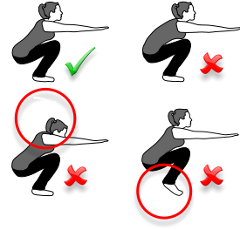
Intra-abdominal pressure (IAP) can help to stabilize the spine during squats. Momentarily stopping the breath and stiffening the abs to make the spine go rigid (think of what you do when you sneeze, or when you know someone is about to punch you in the gut — if you make a little “ungh” sound, you’re probably doing it right) will generate IAP.
Stabilizing the cervical spine
Neck muscles work isometrically to stabilize the cervical spine. A stable cervical spine is critical for contact sports. Thus, folks with greater musculature in the neck and shoulders have a better chance of withstanding cervical impact.
Forcing the cervical spine into excessive flexion or extension with resistance can lead to breakdown of joints and discs.
To build the cervical spine, try incorporating the following exercises. Hold for 10 seconds each, and do 1-5 sets:
- Isometric neck flexion (forwards)
- Isometric neck extension (backwards)
- Isometric lateral neck flexion (right and left)
- Isometric neck rotation (right and left)
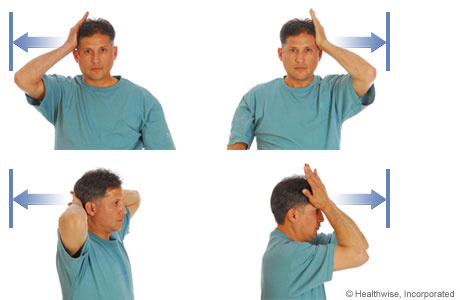
Mobility warmup
Here are some sample mobility drills that can keep the spine mobile yet stable in all the right places.
- Cat/cow spinal warm up
- Foam roll the thoracic region
- Thoracic mobilization
- T push-up
- Hip flexor stretch
- Reverse bridge with back on Swiss ball (for intermediate and advanced folks, begin alternating legs “marching”):
- Squat to stand
Finishing with spinal health movements
To promote spinal health, add some of the following to the end of your workout
- McGill curl-up
- Stir the pot
- Side bridge
- Bird dog (move the leg and arm laterally to make it harder)
- Pallof presses
- TRX back saver
To promote spinal health, try the following between workouts.
Instead of bending at the lumbar spine to pick something up from the ground, try the golfers pick up (unilateral deadlift):
Instead of squatting to get down on the floor, try going into a lunge and keeping your spine neutral.
Mix in some yoga
Yoga may help improve posture through development of extensor muscles and thoracic mobility. Vinyasa yoga is likely the best option for back health due to its dynamic nature. Try to focus on a neutral spine when statically stretching.
Balance
Standing on an unstable surface (like a balance board) recruits stabilization musculature.
While on this surface, assume a position of slight knee and hip bend while contracting the lower torso muscles. Then flex your arms in an alternating fashion while maintaining position. Try this for 1 minute, 2-5 times through. If this doesn’t help your spine, at least you’ll now be known as the balancing flailing loser in your neighbourhood.
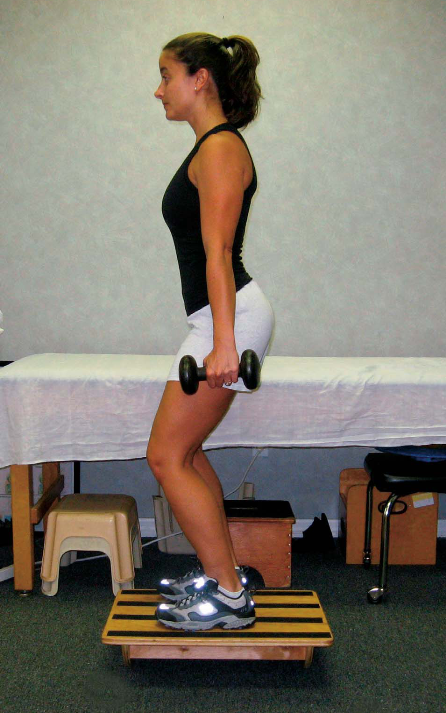
Summary and recommendations
Spinal health comes from a complex interplay of mobility in some areas and stability-strength-endurance in others. Many muscle groups are related to spinal health — ensure that you aren’t prioritizing the “beach muscles” (aka chest and abs) over the more important structural supporters like spinal extensors and glutes/hips/hamstrings.
Sitting is bad news for your spine. Get up and move. If you’re always sitting around, take time to get up, walk, bike, and stretch. Do what feels good and listen to your body.
Extra credit
Between ages 7 and 17 years, the spine can increase in length by about 26%.
Only performing “aerobic” workouts doesn’t seem to build spinal stabilization.
Tightness in the ITB and piriformis can limit pelvic movement.
Spinal compression is high during sit-ups.
Lumbar flexibility tends to increase throughout the day.
Lateral deviation of the spine is known as scoliosis (when viewed from the front/back).
Using a Bodyblade correctly can actually enhance core stability
References
Click here to view the information sources referenced in this article.
Learn more
Want to get in the best shape of your life, and stay that way for good? Check out the following 5-day body transformation courses.
The best part? They're totally free.
To check out the free courses, just click one of the links below.

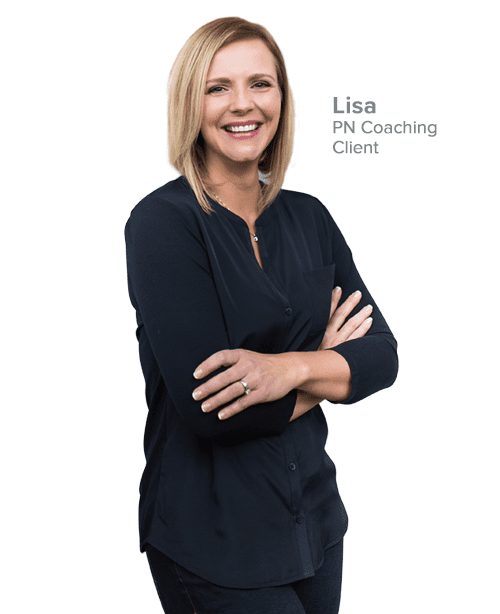
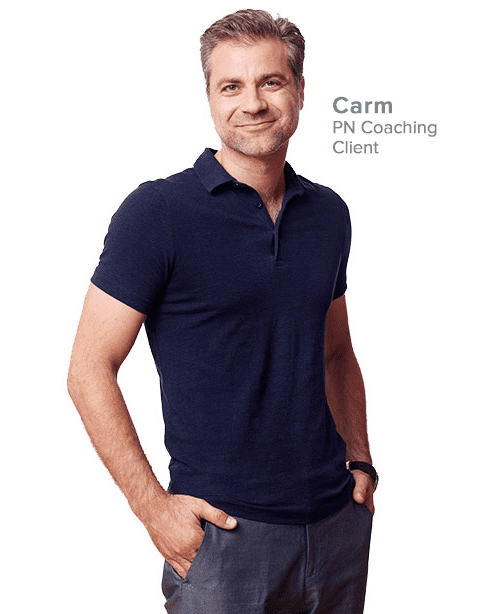
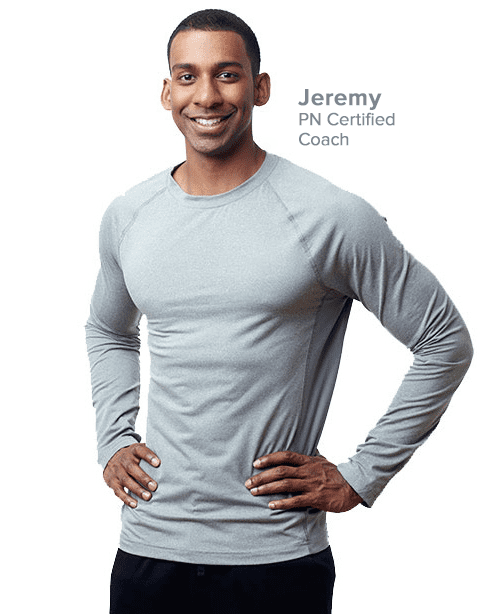
Share